
Tucson was unusually hot, over 110 degrees (F), a bit too much for Mary Lou and our younger granddaughter. who soon succumbed to the temptation and returned to the air-conditioned reptile and aquatic exhibit building. I walked the trails with Graci, our older granddaughter, and her parents. Many species of cactus were in bloom, including the omnipresent Saguaro and Cholla.
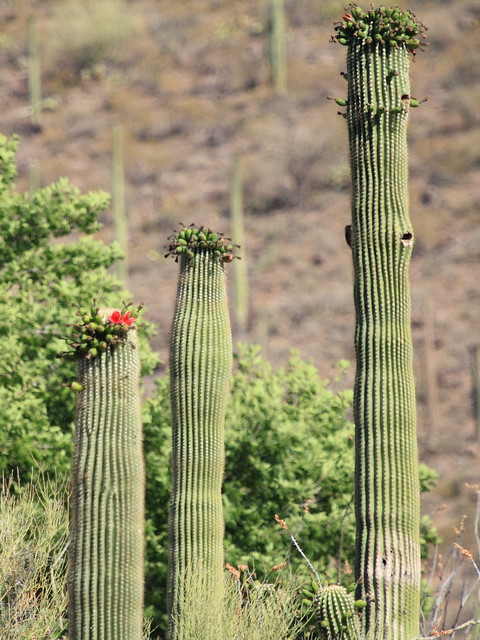

We were greeted by a Cactus Wren, one of many that were present along the trails. Although I have seen this species previously while living in the southwest before I took up nature photography, this was the first of several "life birds" to be newly photographed during our trip.
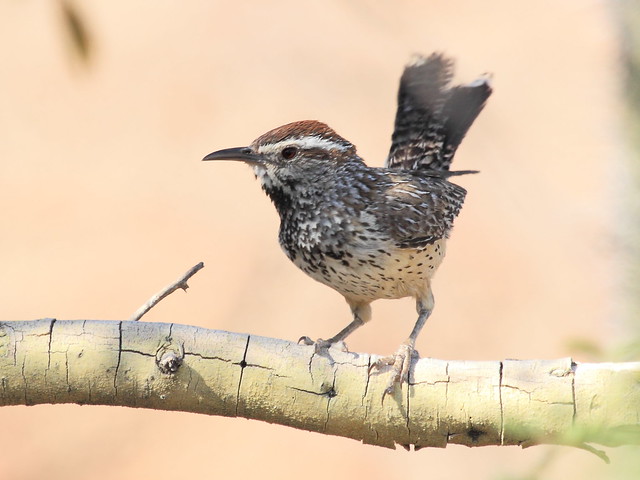
Gila Woodpeckers were also abundant. They excavate their homes in the giant Saguaro Cactus. Interestingly, the inner core of this cactus is soft and full of water, not suitable for immediate use. The woodpeckers therefore wait several months for the pulp to dry and form a solid shell around the entire nest cavity. Somewhat like a thermos bottle, the extra layer provides insulation against the brutal heat.
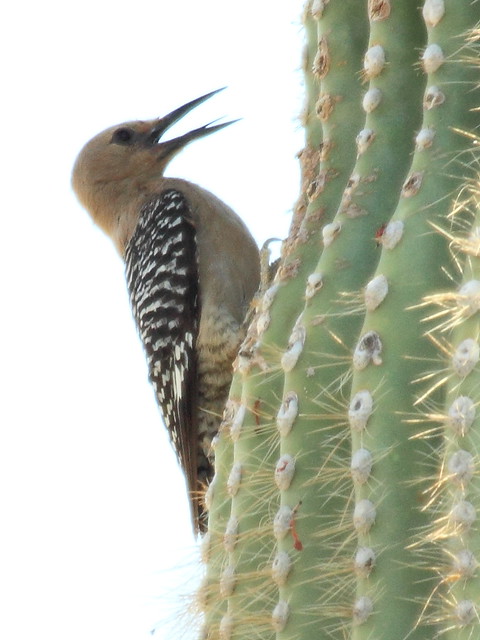
Abandoned woodpecker holes provide homes for other creatures. European Starlings often appropriate a cavity even before the woodpecker occupies it. We found House Sparrows in a number of them.
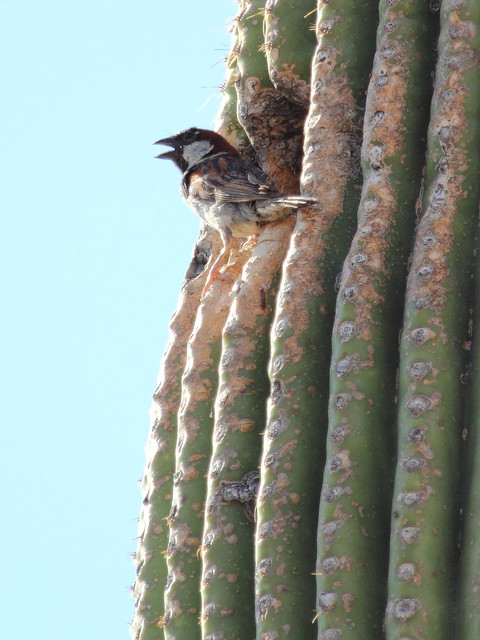

This Saguaro, like many others, was topped by ripe fruit.
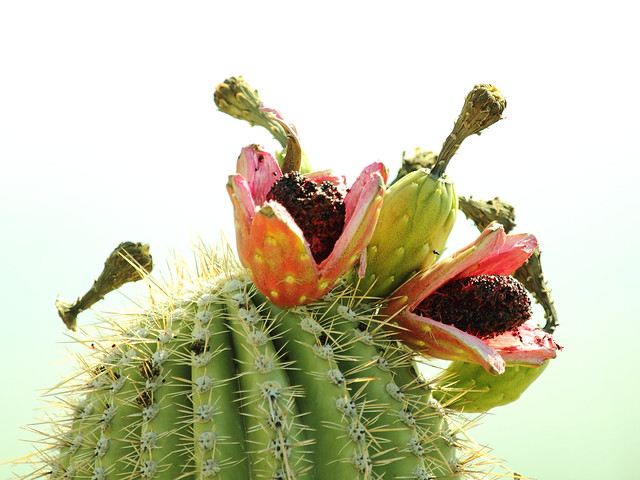
White-winged Doves, now common in our Florida neighborhood and expanding their range over much of the US and even into Canada, were primarily desert birds. Here in the Sonora Desert, they long ago developed a dependency upon the Saguaro Cactus, drinking the nectar of its flowers and eating its seeds. This dove even regulates its breeding to coincide with the availability of this food source. They occupied many of the tops of the huge plants, sometimes seeming to be waiting for the fruits to ripen.
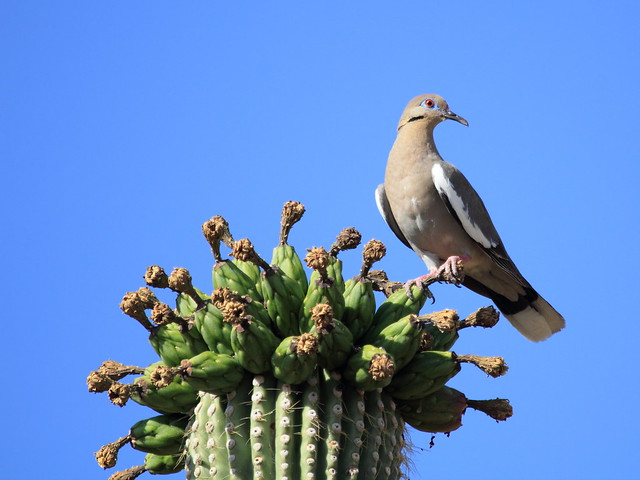
We also saw Curve-billed Thrashers foraging on the cactus, apparently seeking insects.
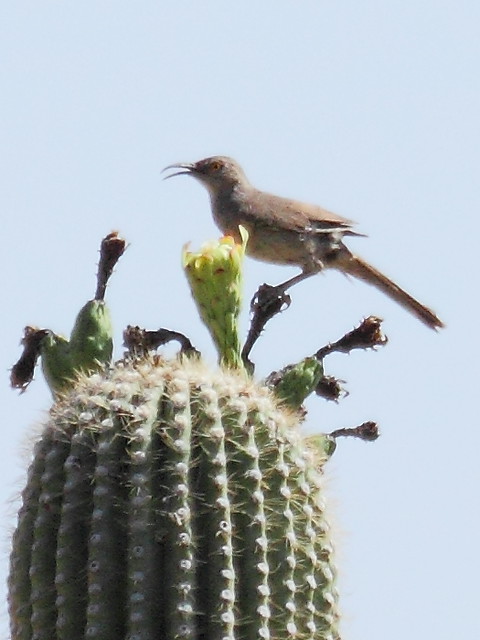
Graci was very energetic, replenishing her water bottle and often getting far ahead of us on the trails. Traveling light, I left my usual 420x fixed lens back in Florida, as my son-in-law had offered me use of his new 100-400x zoom with a f/4.0-5.6 lens with my Canon 60D camera. It was much heavier, and I soon wished I had brought my monopod to help steady it.

Once Graci excitedly ran back, telling us to come quickly, as she had seen an Elf Owl. As these tiny owls also use the woodpecker burrows, we expected to find one looking out at us from a hole in the cactus. As it turned out, the owl was a captive in one of the outside exhibits.
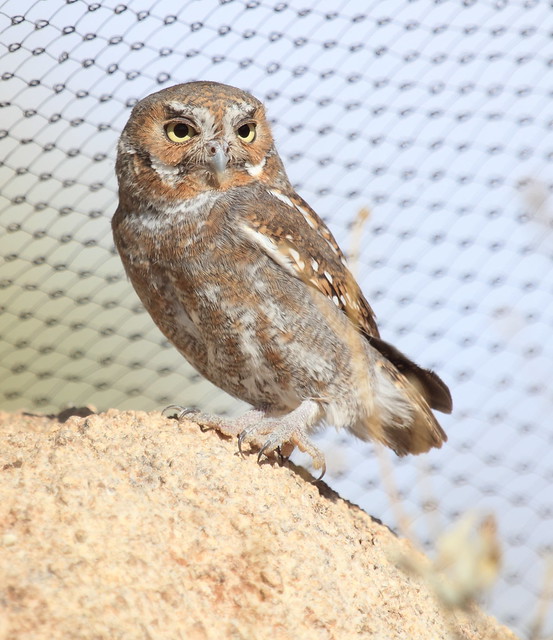
The exhibits were scattered about along the trails, and their occupants usually were in naturalistic surroundings. This reclusive Ocelot was particularly beautiful.
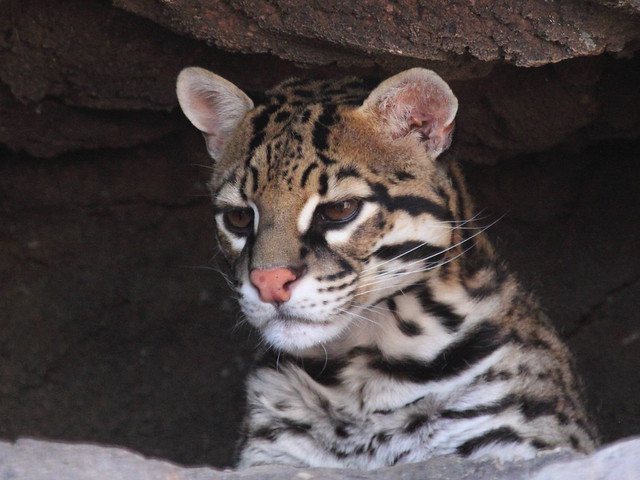
Like the Ocelot, a Bobcat spent most of its time resting on a shady rock ledge.
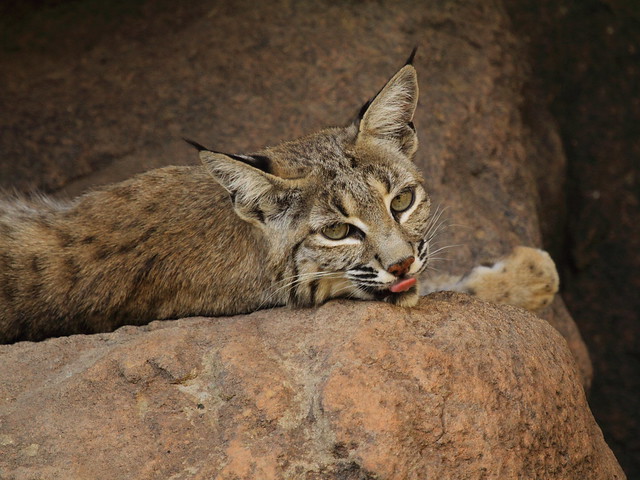
This brief visit turned out to provide our only opportunity to bird in Southeast Arizona. We put family first and had a delightful visit with another of Mary Lou's brothers and his wife that evening, before heading for Lazydays RV Campground. There followed a day of fun in Tombstone and the OK Corral. We anticipated that Sedona, our next stop, would provide us respite from the heat and more time to commune with nature.
wow! thanks for braving the excessive heat to get these! loved the cacti!!! and all the natural birds you caught utilizing them! LOVE the cactus wren. even your 'captive' shots are beautiful!
ReplyDeleteI love the cacti and all the birds and the animals. The ocelot is so gorgeous.
ReplyDeleteThe cactus are pretty in bloom and it is interesting to see the birds on them. I can't imagine the heat of a day like that, you must love photographing birds.
ReplyDeleteFascinating series!! Boom & Gary of the Vermilon River, Canada.
ReplyDeleteHi Ken. Temperatures of 110 (F) ... whow, at the moment we think it's hot now its reached 80!!
ReplyDeleteInteresting to hear how the Gila utilises the cacti.
Apart from the weight I'd be interested to learn what you thought of the 100-400 lens.
I love the cacti and its blooms, very pretty. Awesome bird sightings and photos. Great post.
ReplyDeleteOh I remember collecting the fruit of the saguaro and making jelly!! Yes, jelly! Loved the sweet/tartness.
ReplyDeleteAnd the curved billed thrasher...with their orange eyes always looked so evil when they were in our yard in Tucson. The cactus wren is one of my favorites...especially when they would nest in our saguraos...what a messy nest. It was always funny to watch them tote in a huge [nearly complete] plastic grocery sack into the cactus; building their home.
You were very brave to be out in that heat! But the birds you and Graci saw were worth it. :)
ReplyDeleteHi, Frank-- thanks for stopping by and for your comments.
ReplyDeleteUsing my son-in-law's 100-400mm f/4.0-5.6 did incite "lens envy" in me, especially when I first tried it out sitting in his back yard and zooming in on feeder birds. I had two issues of concern. As mentioned, it is quite heavy to tote out into the wild as is my habit. I sometimes walk 3-4 miles with monopod, a liter of water, the pocket point-and-shoot as well as a small pack with extra batteries, etc. It is also very nose-heavy when fully extended to 400 mm. For stationary work or tripod use this should not be an issue.
A bit more problematic has been the autofocus. It may be related to the way it works with my Canon 60D rather than the lens itself, but when I mentioned it on the Canon forum on Linkedin one other reader cited a similar issue with another camera. I find that when using point focus on smaller subjects it wants to focus on the background even if the bird is perched out in the open. If there is any intervening vegetation the focus area seems to be much larger than when I use my 420 mm fixed lens system (300mm L f/4.0 + 1.4x extender). It was especially disappointing when I found a flock of Phainopeplas in Oak Creek Canyon and every single shot of over a dozen was out of focus. I went back and luckily found them again. This time I took many shots using manual focus, bracketing them as I have eyesight problems. This resulted in four good images, so it turned out well.
Maybe with more experience I will learn to use the autofocus more effectively under these circumstances. It did work well with wider shots and videos.
Looks like it was a fun and productive trip - lots of beautiful shots. It's nice to see that your granddaughter shares your interest in nature.
ReplyDeleteBeautiful place such lovely flowers and birds.
ReplyDeleteLoved your story today Ken. Of course you will know we don't get cacti in the UK and it was only when visiting Egypt I realised how they host so many birds, especially nectar drinkers. It was good to see and read of the white winged doves not only expanding but using the cacti resource to do so. Young Graci seems to be developing her interest in wildlife thanks to Gramps - well done. Great campervan by the way - good birding vehicle as long as a few windows open hide-like?
ReplyDeleteOkay Ken...I'm back visiting in my Hootin' Anni Admin today, and viewing again your desert dwellers. But I must confess...I've been meaning to ask you this several times and keep forgetting to add it to the comment after I type about the bird photos you share. Today I'm gonna.......
ReplyDeleteHow do you pronounce your granddaughters name Graciela...is it [or am I even close?] GRAH sea ELLA? Help me out. I think it's a beautiful name.
Hi, Anni-- your pronunciation is correct. She spells her nickname Graci (GRAH-sea) to avoid being called "GRACE-EE." I too love her name. It is so unusual in her school and neighborhood that she does not need to use her last name.
DeleteVery interesting habitat and great to see so many birds making use of holes in the cacti. The little wren is especially beautiful.
ReplyDeleteIsn't it so wonderful to be able to visit different parts of the Americas and see different speices of flowers and birds. The Cactus Wren was my favorite in this series, just too cute~
ReplyDeleteOh what an adventure! Just gorgeous shots Ken, and I of course now have lens envy!
ReplyDeleteGreat series.
ReplyDeletethis certainly is a wow post! I thought what a holiday in that huge trailer-way to go! The heat I know is no fun (we get it here New Year), but the birds you saw and those fantastic cactuses' hopefully were worth your walk outdoors. I'm amazed at all the birds out in the heat with the cacti ...a great post (I already said that didn't I?)
ReplyDeleteSuch a lovely post with both bird and beast. I'd love to explore Arizona, just not in the heat of summer.
ReplyDeleteWhat a gorgeous shot of the cactus wren! Hand held with a heavy lens, you need a prize!
@ Anni-- I still don't get the hang of the ins and outs of Blogger, and do not see my reply under your comment, so here goes again as a separate comment:
ReplyDeleteHi, Anni-- your pronunciation is correct. She spells her nickname Graci (GRAH-sea) to avoid being called "GRACE-EE." I too love her name. It is so unusual in her school and neighborhood that she does not need to use her last name. on Summer birding in Arizona heat
A most unusual set of pics, For me the Dove stands out and takes the prise.
ReplyDeleteAll the best Gordon.